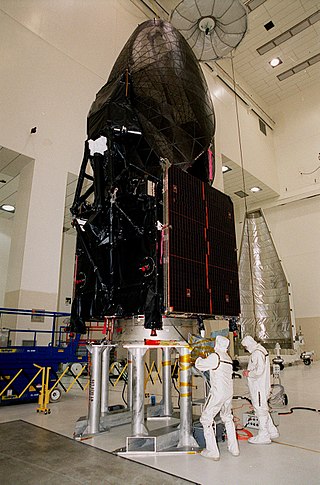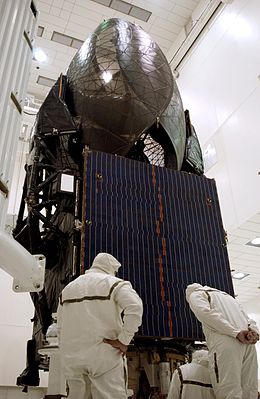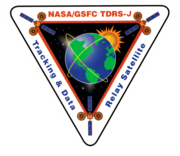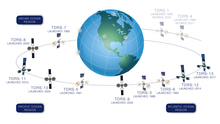
Intelsat 603 or IS-603, previously named Intelsat VI F-3, is a communications satellite operated by Intelsat. Launched in 1990, it was the second of five Intelsat VI satellites to be launched. The Intelsat VI series was constructed by Hughes Aircraft, based on the HS-389 satellite bus.

TDRS-8, known before launch as TDRS-H, is an American communications satellite, of second generation, which is operated by NASA as part of the Tracking and Data Relay Satellite System. It was constructed by Boeing is based on the BSS-601 satellite bus.

TDRS-B was an American communications satellite, of first generation, which was to have formed part of the Tracking and Data Relay Satellite System. It was destroyed in 1986 when the Space ShuttleChallenger disintegrated 73 seconds after launch.

TDRS-5, known before launch as TDRS-E, is an American communications satellite, of first generation, which is operated by NASA as part of the Tracking and Data Relay Satellite System. It was constructed by TRW is based on a custom satellite bus which was used for all seven first generation TDRS satellites.
EchoStar X, also known as EchoStar 10, is an American geostationary communications satellite which is operated by EchoStar on behalf of Dish Network. It is positioned in Geostationary orbit at a longitude of 110° West, from where it is used to provide direct broadcasting services to the United States.
INSAT-2E is an Indian geostationary communications and weather satellite which is operated by the Indian National Satellite System. It is positioned in geostationary orbit at a longitude of 83° East, from where it is used to provide communications services to Asia and Australia. It also carries two meteorological instruments; the Very High Resolution Radiometer, and a CCD camera capable of returning images with a resolution of one kilometre.

TDRS-3, known before launch as TDRS-C, is an American communications satellite, of first generation, which is operated by NASA as part of the Tracking and Data Relay Satellite System. It was constructed by TRW, and is based on a custom satellite bus which was used for all seven first generation TDRS satellites.

TDRS-4, known before launch as TDRS-D, is an American communications satellite, of first generation, which was operated by NASA as part of the Tracking and Data Relay Satellite System from 1989 until 2011. It was constructed by TRW, based on a custom satellite bus which was used for all seven of the first generation TDRS satellites.

TDRS-6, known before launch as TDRS-F, is an American communications satellite, of first generation, which is operated by NASA as part of the Tracking and Data Relay Satellite System. It was constructed by TRW, and is based on a custom satellite bus which was used for all seven first generation TDRS satellites.

TDRS-7, known before launch as TDRS-G, is an American communications satellite, of first generation, which is operated by NASA as part of the Tracking and Data Relay Satellite System. It was constructed by TRW as a replacement for TDRS-B, which had been lost in the Challenger accident, and was the last first generation TDRS satellite to be launched.

TDRS-9, known before launch as TDRS-I, is an American communications satellite which was operated by NASA as part of the Tracking and Data Relay Satellite System. It was constructed by the Boeing Satellite Development Center, formerly Hughes Space and Communications, and is based on the BSS-601 satellite bus. It was the second Advanced TDRS, or second-generation Tracking and Data Relay Satellite, to be launched.
Galaxy 11 is an American geostationary communications satellite which is operated by Intelsat. It is located in geostationary orbit at a longitude of 32.8 degrees east, where it serves as a backup to the Intelsat 802 spacecraft. It was originally operated at 99° West and later spent most of its operational life at 91° West, from where it was used to provide communications services to Brazil and North America.

GOES-2, known as GOES-B before becoming operational, was a geostationary weather satellite which was operated by the United States National Oceanic and Atmospheric Administration as part of the Geostationary Operational Environmental Satellite system. GOES-2 was built by Ford Aerospace, and was based on the satellite bus developed for the Synchronous Meteorological Satellite programme. At launch it had a mass of 295 kilograms (650 lb). It was positioned in geostationary orbit, from where it was used for weather forecasting in the United States. Following its retirement as a weather satellite, it was used as a communications satellite until its final decommissioning in 2001.

GOES-3, known as GOES-C before becoming operational, was an American geostationary weather and communications satellite. It was originally built for the National Oceanic and Atmospheric Administration as part of the Geostationary Operational Environmental Satellite system, and was launched in June 1978. It was positioned in geostationary orbit, from where it was initially used for weather forecasting in the United States. Since ceasing to function as a weather satellite in 1989, it was used as a communications satellite, and spent over thirty-eight years in operation. GOES-3 was decommissioned 29 June 2016 at the Center for Southeastern Tropical Advanced Remote Sensing facility in Miami, Florida.

GOES-6, known as GOES-F before becoming operational, was a geostationary weather satellite which was operated by the United States National Oceanic and Atmospheric Administration as part of the Geostationary Operational Environmental Satellite system. Launched in 1983, it was used for weather forecasting in the United States.
Intelsat 601, previously named Intelsat VI F-1, was a communications satellite operated by Intelsat, and later Europe*Star. Launched in 1991, it was the last of five Intelsat VI satellites to be launched. The Intelsat VI series was constructed by Hughes Aircraft, based on the HS-389 satellite bus.
Intelsat 602, also known as IS-602 and previously named Intelsat VI F-2, is a communications satellite operated by Intelsat. Launched in 1989, it was the first of five Intelsat VI satellites to be launched. The Intelsat VI series was constructed by Hughes Aircraft, based on the HS-389 satellite bus. Intelsat 602 was decommissioned in July 2012.
Intelsat 604, previously named Intelsat VI F-4, was a communications satellite operated by Intelsat. Launched in 1990, it was the third of five Intelsat VI satellites to be launched. The Intelsat VI series was constructed by Hughes Aircraft, based on the HS-389 satellite bus.
Intelsat 605, previously named Intelsat VI F-5, was a communications satellite operated by Intelsat. Launched in 1991, it was the fourth of five Intelsat VI satellites to be launched. The Intelsat VI series was constructed by Hughes Aircraft, based on the HS-389 satellite bus.

TDRS-11, known before launch as TDRS-K, is an American communications satellite which is operated by NASA as part of the Tracking and Data Relay Satellite System. The eleventh Tracking and Data Relay Satellite is the first third-generation spacecraft.


















